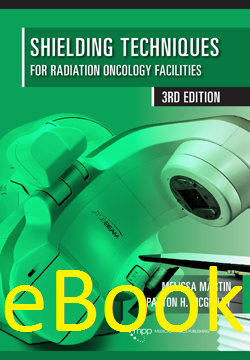
Shielding Techniques for Radiation Oncology Facilities, 3rd Edition, eBook
Author: Melissa Martin and Patton H. McGinleyISBN: 9781951134013
Published: July 2020 | 170 pp | eBook
Price: $ 100.00
Doody's | 2020
REVIEWER - Anees H Dhabaan, PhD(Emory University School of Medicine)
**Description**
This is the third edition of a book, first published in 1998, on the shielding for radiation oncology facilities that cover the shielding designs of the conventional linear accelerator, as well as advanced radiotherapy equipment, such as the MR_Linear Accelerator and Reflexion (Linear Accelerator with CT and PET). This well-referenced, comprehensive book also covers radiation shielding surveys. The book is designed to be comprehensive, covering the shielding of most radiotherapy treatment rooms. The authors have made an extra effort to provide a multitude of examples to illustrate typical shielding calculations. In addition to the main chapters, the authors include appendixes that provide the properties of various shielding materials.
**Purpose**
From a practical perspective, the authors successfully address the most paramount aspects of radiation shielding for radiotherapy. They highlight all the necessary information that should be useful for clinical medical physicists, physics residents, and graduate medical physics students. This edition incorporates NCRP151 methodology into the description of the shielding calculations, hence making this book alone a comprehensive guide for radiation shielding targeted toward clinical medical physicists.
**Audience**
This book is primarily directed toward practicing medical physicists who seek a guide for radiation shielding of conventional linear accelerators and advanced radiotherapy equipment. In my judgment, the text can also serve as a primary reference for teaching shielding techniques, which will aid medical physics residents and medical physics graduate students. Although this revision does not include homework problems, it has many solved calculation exercises that illustrate shielding concepts. Together with the detailed text for the shielding topics, these examples craft this book to be a suitable textbook on shielding for students and clinical medical physicists. When teaching shielding to medical physics residents and graduate students, I have incorporated this book in our institution as the main textbook. From this experience, I would strongly recommend this text to general medical physicists, medical physics residents, and graduate students.
**Features**
This book consists of nine chapters and two appendixes. All chapters, excluding chapter 1, include useful and well-designed black and white illustrations and figures to assist readers. There are numerous tables containing data pertinent to the text, which can be utilized when comprehending the example exercises. There is an enormous number of solved examples, which, in my view, is a very useful feature of the book. These examples make it easier for readers to understand the topic. I found the structure of the text valuable for clinical medical physicists and trainees to help with review and examination preparation. Succeeding chapter 9, the authors present a rich bibliography (a total of 108 articles) that is referenced throughout the chapters. The chapters start from the history of X-Room shielding, which covers conventional linear accelerator shielding techniques, and extends to shielding designs for new technologies and various radiotherapy machines. Chapter 1 chronologically introduces the history of x-ray room shielding. The authors begin with the "Years of Discovery" (1895-1900) of x-rays and transition to describing the "Golden Age of X-Ray Generators" and early linear accelerators (1913-1940), "Early Betatrons and Linear Accelerators" (1941-1960), and concluding with the "Modern Radiation Therapy" period (1960-present). Chapters 2 and 3 cover the conventional linear accelerators room and maze shielding design. These two chapters provide detailed calculation methods and design examples for primary and secondary barriers, as well as maze design. The methods are simplified; several illustrations, steps, and data tables are provided, making the text easy to comprehend and use by the medical physicist. Chapters 4 and 5 present clear instructions for the shielding of high-energy photon beams (greater than 6 MV) and deal with neutron and capture-gamma shielding for doors and mazes. Chapter 5 gives recommendations for direct door shielding, large penetrations for air-conditioning ducts, and other penetrations. Chapter 6 gives recommendations and detailed exercises on metal and concrete shields, especially where space is limited. Chapter 7 includes a diverse range of topics, including skyshine, ozone production, air activation, and shielding recommendations for new technologies of treatment. Examples of recommendations include Cyber-Knife, MR-linear accelerator, and superficial and orthovoltage machines. Chapter 8 provides designs, equations, examples, and recommendations for the shielding of HDR, Gamma knife, and Gamma-Pod rooms. In chapter 9, the authors highlight clear instructions and recommendations on how to properly carry out a shielding room survey. Examples to help readers write a survey report are also incorporated within the chapter. Following chapter 9 are the appendixes, which outline parameters used in the shielding calculations as well as properties of different shielding materials. Covering all shielding topics in one book makes it easier for a physicist to have a reference for shielding. After analyzing this text, it is my view that the book covers all of the shielding designs needed for photon therapy machines up to date.
**Assessment**
This book is inclusive of conventional shielding designs of linear accelerators as well as modern treatment machines. It provides recommendations and examples to assist practicing medical physicists, medical physics residents, and graduate students in building their knowledge of treatment room shielding. This comprehensive textbook is, in my opinion, the only one in the field of medical physics to provide thoroughly detailed shielding design solutions for photon therapy rooms. As for limitations, the only topic that is missing from this book is that of proton room shielding. Another flaw to point out is that figure 4-3 is missing from the text. If I were to add any other critique, it would be to reorganize the topics addressed in chapter 7 into subcategories or divide them into two chapters, with the first covering skyshine, ozone, and activation, and the second chapter covering shielding designs for modern technologies.
-----------------------------------------------------------
Weighted Numerical Score: 97 - 5 Stars!


